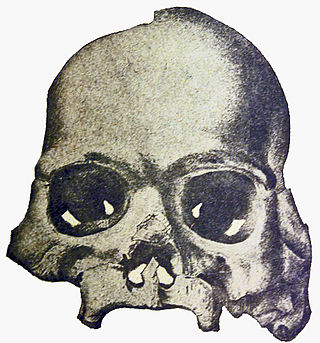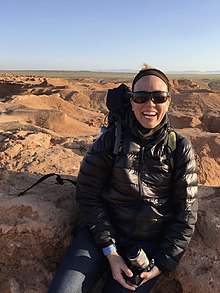
Fire is the rapid oxidation of a material in the exothermic chemical process of combustion, releasing heat, light, and various reaction products. At a certain point in the combustion reaction, called the ignition point, flames are produced. The flame is the visible portion of the fire. Flames consist primarily of carbon dioxide, water vapor, oxygen and nitrogen. If hot enough, the gases may become ionized to produce plasma. Depending on the substances alight, and any impurities outside, the color of the flame and the fire's intensity will be different.
A nerd is a person seen as overly intellectual, obsessive, introverted, or lacking social skills. Such a person may spend inordinate amounts of time on unpopular, little known, or non-mainstream activities, which are generally either highly technical, abstract, or relating to niche topics such as science fiction or fantasy, to the exclusion of more mainstream activities. Additionally, many so-called nerds are described as being shy, quirky, pedantic, and unattractive.

Stephen Edwin King is an American author. Widely known for his horror novels, he has been crowned the "King of Horror". He has also explored other genres, among them suspense, crime, science-fiction, fantasy and mystery. Though known primarily for his novels, he has written approximately 200 short stories, most of which have been published in collections.

Mary Anning was an English fossil collector, dealer, and palaeontologist. She became known internationally for her discoveries in Jurassic marine fossil beds in the cliffs along the English Channel at Lyme Regis in the county of Dorset, Southwest England. Anning's findings contributed to changes in scientific thinking about prehistoric life and the history of the Earth.
Turkana Boy, also called Nariokotome Boy, is the name given to fossil KNM-WT 15000, a nearly complete skeleton of a Homo erectus youth who lived 1.5 to 1.6 million years ago. This specimen is the most complete early hominin skeleton ever found. It was discovered in 1984 by Kamoya Kimeu on the bank of the Nariokotome River near Lake Turkana in Kenya.
Stephen J. Pyne (1949–present) is an emeritus professor at Arizona State University, specializing in environmental history, the history of exploration, and especially the history of fire.

There have been several cases of exploding whale carcasses due to a buildup of gas in the decomposition process. This would occur if a whale stranded itself ashore. Actual explosives have also been used to assist in disposing of whale carcasses, ordinarily after towing the carcass out to sea, and as part of a beach cleaning effort. It was reported as early as 1928, when an attempt to preserve a carcass failed due to faulty chemical usages.

The "Dear Boss" letter was a message allegedly written by the notorious unidentified Victorian serial killer known as Jack the Ripper. Addressed to the Central News Agency of London and dated 25 September 1888, the letter was postmarked and received by the Central News Agency on 27 September. The letter itself was forwarded to Scotland Yard on 29 September.

Mark Carwardine is a British conservationist who achieved widespread recognition with his 20-year conservation project – Last Chance to See – which involved round-the-world expeditions with Douglas Adams and Stephen Fry. The first series was aired on BBC Radio 4 in 1990, and the second, a TV series, on BBC2 in 2009. There are two books about the project: Last Chance to See, which he co-wrote with Adams (1990), and Last Chance to See: In the footsteps of Douglas Adams (2009). He is a leading and outspoken conservationist, and a prolific broadcaster, columnist and photographer.

"Lisa the Skeptic" is the eighth episode of the ninth season of the American animated television series The Simpsons. It first aired on Fox in the United States on November 23, 1997. On an archaeological dig with her class, Lisa discovers a skeleton that resembles an angel. All of the townspeople believe that the skeleton actually came from an angel, but skeptical Lisa attempts to persuade them that there must be a rational scientific explanation. The episode's writer, David X. Cohen, developed the idea after visiting the American Museum of Natural History, and decided to loosely parallel themes from the Scopes Monkey Trial. The episode also makes allusions to actual hoaxes, such as the Cardiff Giant.
The year 2005 in art involves various significant events.

The Calaveras Skull was a human skull found in 1866 by miners in Calaveras County, California, which was presented as evidence that humans were in North America as early as during the Pliocene Epoch, and which was used to support the idea the humans, mastodons, and mammoths had coexisted. The skull was later revealed to be a hoax, although it is now known that humans, mastodons, and mammoths had indeed coexisted, but much more recently. Coincidentally, calaveras is the Spanish word for skulls.

AL 288-1, commonly known as Lucy or Dinkʼinesh, is a collection of several hundred pieces of fossilized bone comprising 40 percent of the skeleton of a female of the hominin species Australopithecus afarensis. It was discovered in 1974 in Ethiopia, at Hadar, a site in the Awash Valley of the Afar Triangle, by Donald Johanson, a paleoanthropologist of the Cleveland Museum of Natural History.

The Davenport Tablets are three inscribed slate tablets found in mounds near Davenport, Iowa on January 10, 1877, and January 30, 1878. If these tablets were real, they would have been proof for the argument that the people who built the Native American mounds, called the Mound Builders were an ancient race of settlers. The Davenport Tablets were originally considered authentic, though opinion shifted after 1885 and they are now considered a hoax.
Philosophy of design is the study of definitions of design, and the assumptions, foundations, and implications of design. The field, which is mostly a sub-discipline of aesthetics, is defined by an interest in a set of problems, or an interest in central or foundational concerns in design. In addition to these central problems for design as a whole, many philosophers of design consider these problems as they apply to particular disciplines.
Object Lessons is "an essay and book series about the hidden lives of ordinary things". Each of the essays and the books investigate a single object through a variety of approaches that often reveal something unexpected about that object. As stated in the Object Lessons webpage, "Each Object Lessons project will start from a specific inspiration: an anthropological query, ecological matter, archeological discovery, historical event, literary passage, personal narrative, philosophical speculation, technological innovation—and from there develop original insights and novel lessons about the object in question."

Fake news or information disorder is false or misleading information claiming the aesthetics and legitimacy of news. Fake news often has the aim of damaging the reputation of a person or entity, or making money through advertising revenue. Although false news has always been spread throughout history, the term fake news was first used in the 1890s when sensational reports in newspapers were common. Nevertheless, the term does not have a fixed definition and has been applied broadly to any type of false information presented as news. It has also been used by high-profile people to apply to any news unfavorable to them. Further, disinformation involves spreading false information with harmful intent and is sometimes generated and propagated by hostile foreign actors, particularly during elections. In some definitions, fake news includes satirical articles misinterpreted as genuine, and articles that employ sensationalist or clickbait headlines that are not supported in the text. Because of this diversity of types of false news, researchers are beginning to favour information disorder as a more neutral and informative term.
Pyrocene is a proposed term for a new geologic epoch or age characterized by the influence of human-caused fire activity on Earth. The concept focuses on the many ways humans have applied and removed fire from the Earth, including the burning of fossil fuels and the technologies that have enabled people to leverage their influence and become the dominant species on the planet. The Pyrocene offers a fire-centric perspective on human history that is an alternative to or complementary term for the Anthropocene. Like the Anthropocene, the concept suggests that human activity has shaped the Earth's geology and identifies fire as humanity's primary tool for shaping the planet and its environment.

The Pokémon Fossil Museum is a travelling exhibition based on the Pokémon media franchise, displaying illustrations and "life-size" sculpted renditions of the skeletons of fossil Pokémon, along with the actual fossils of the real-life prehistoric animals and other organisms on which they were based. The exhibit was created by the National Museum of Nature and Science and The Pokémon Company.
Peckham Rock, also called Wall Art, is a 2005 artwork by British street artist Banksy, in the form of a lump of concrete decorated in the style of a cave painting and depicting "a supposed prehistoric figure pushing a shopping trolley". It was originally displayed in the British Museum, without the knowledge of the museum staff, after being installed there by Banksy.












